South Florida Surfing pioneer and legend Ron Heavyside passed away on Apri 15th 2018. This article was published just days before his passing…
County Pocket: Through time and tide, Nomad Surf Shop rolls on
Re-posted from The Coastal Star http://thecoastalstar.com
By Ron Hayes
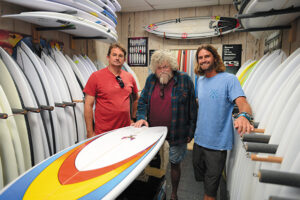
Ron Heavyside with his sons Ronnie (L) and Ryan (R) Photo by Jerry Lower- Coastal Star
On a breezy Friday evening not long ago, Ron Heavyside sat in an old wooden porch chair in front of his Nomad Surf Shop, nursing a Coors Light and squinting west over North Ocean Boulevard at the fat orange sun sliding down toward the long yawn into dusk.
Can it really be 50 years since he opened the shop?
Heavyside was 19 then. He’s 69 now. The young man who surfed is an old man who sits, with half a century of triumph and tragedy behind him. But he’s still here, and so is the shop.
“It seems like yesterday,” Heavyside said, and sipped the beer. “But it’s going to feel like 50 years in about 15 minutes when that sun hits my chair.”
Ronald Richard Heavyside was born in Montreal, moved to Los Angeles at 2, and arrived in Ocean Ridge in 1962, just turning 14. He never left.
“My father knew a guy in Briny Breezes,” he remembered. “That’s how we wound up here.” His father, Richard, opened a TV repair shop across the road from Briny, beside a Pure Oil gas station that later became a real estate office. The TV shop was south of the station, with the Capri Lounge, which later became Dante’s Den, to the north.
While his father sold and repaired TVs, young Ron rode surfboards. And pretty soon he was building them. At 15, still a student at Seacrest High School, Heavyside went to work for the Caribbean Surfboard Co. on East Atlantic Avenue in Delray Beach. “Val Giersdorf hired me and I worked there through 12th grade,” he recalled.
Heavyside was building surfboards before he built Nomad surfboards, and there were Nomad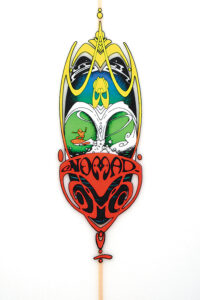
surfboards before there was a Nomad Surf Shop. “It all began with five guys and $250 each,” he explained.
Pooling their money, he and his friends rented a small industrial workshop on Hypoluxo Road, bought 12 foam surfboard forms and a drum of polyurethane resin and went to work.
“We always referred to it as a surfboard factory,” Heavyside said. “I rented it from a guy named Ralph McKeral, and he told me, ‘You’ve got a good business because there’s always going to be a new generation of kids coming along.’”
The boards were 10 feet long at first, then the fashion changed. They shrank to 8 feet, 7 feet.
“Those were easier to make,” Heavyside said.
He and his friends dubbed them “Nomad” boards because the name evoked all those passionate surfers who wander the world in search of the perfect wave.
“And then one day my old man said, ‘You can have part of the shop.’ My shop was 12-by-16 feet at first, just a little corner of the TV store that my dad gave me.”
This was early in 1968. Heavyside put a wall in the middle to separate the surfboards from the TV sets, bought some paneling at Lindsley Lumber, and traded a board for some shag carpeting.
“You’d be surprised what people will do for a surfboard,” he said, and the setting sun put a twinkle in his eye — or maybe it was the memory. “I’ve traded boards for a lot of things….”
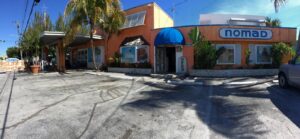
Heavyside sold the Nomad boards for about $175 each and the Nomad T-shirts for $3. The business flourished. At one time, he had shops in Boca Raton, Delray Beach and Cocoa.
“Spring and summer we made a lot of money,” he said, “but if there’s no surf it was like a ski area. No snow, no skiing.”
Eventually, Heavyside started selling wholesale, loading 125 boards into a U-Haul trailer he pulled up and down the East Coast behind a green-paneled Dodge Tradesman van.
“I had a dealer in every damn town,” he remembered. Cocoa; Daytona; Myrtle Beach, South Carolina; Ocean City, Maryland — all the way up to Hampton Beach, New Hampshire.
“I pulled into a Red Carpet Inn off I-95 outside St. Augustine one night and thieves took my truck and trailer,” he said. The truck and U-Haul were found the next morning, stuck in the sand and abandoned with the surfboards still inside. e climbed in and kept driving.
Family ups and downs
In 1974, Heavyside married the former Beth Walsh, whose sales savvy helped the business grow. She brought bikinis and other beachwear into the shop, and by 1984 Nomad had taken over both the former gas station and lounge. The tiny corner of a TV shop had grown to a sprawling business of 8,000 square feet and annual sales nearing $1 million.
The couple had two boys, Ronnie, born in 1979, and Ryan in 1984, but the 1990s brought conflict and tragedy. Beth Heavyside filed for divorce three times between 1987 and 1993, but the two always reconciled. In January 1996, the tension erupted when Heavyside changed the locks on the store.
According to a 1996 report in The Palm Beach Post, the couple battled over ownership of the business and Beth Heavyside’s behavior became increasingly erratic.
In May 1996, she was charged with trying to set fire to a house where she thought Ron was sleeping with his girlfriend. The following January, Beth Heavyside died. She was 47.
“I just got drunk every day after my wife died,” Heavyside said. The sun had slipped lower, ready to sink beneath the former gas station’s overhanging roof and reach his chair. “I used to drink Jack Daniel’s like it was water.”
After his mother’s death and his father’s dalliance with Jack Daniel’s, Ronnie Heavyside found himself running the business, which was already 29 years old.
“I was 18, and I had no choice,” he said. “When we were younger, we lived down the street in Ocean Ridge, and when I took over I moved back to the County Pocket. It was pretty much upside down when I took over, and I got it all built back up.”
He’s 38 now, and still runs the business most days. “I played a lot of baseball when I was younger,” he remembered, “but I had no choice. I could have gone places and played ball, but I was a surfer for sure.”
Ryan Heavyside was 12 when his mother died, but he’d been surfing since the age of 5, and was ranked 11th in the boys division of the Surf America team in 1996.
“When your dad builds surfboards, you surf,” he said. Today, both sons share the daily demands of running the shop. The millennium turned, the business continued to grow, and all the local kids who took up surfing as teenagers grew, too.
Generational changes
Jeremy Stewart was born and raised in Lake Worth. “I’ve been surfing since fifth grade, and I’m 38 now, so I’ve been coming here at least 30 years,” he said. “I love this place. They’ve got the best surfboards. No lemons. It’s a family spot. It’s the roots — you know what I mean?”
Today, the surfboards that sold for $175 in 1969 will cost you anywhere from $595 to $1,500, and the $3 T-shirts with the Nomad logo sell for $20.
Somewhere along the way, the Nomad Surf Shop went from being a shop that sold mostly surfboards to a shop that sells mostly everything else.
“T-shirts are our No. 1- selling item,” Ryan Heavyside said.
Wander the labyrinth of aisles nowadays and you’ll find surfboards, yes, but mostly you’ll find sunglasses, sandals and watches, skateboards and paddle boards, bikinis, baggies, skirts, tops — and T-shirts, of course, a whole wall of T-shirts with more than a dozen Nomad designs to choose from.
The shop hosts a food truck, parked outside every Wednesday through Sunday for healthy smoothies and juices.
On St. Patrick’s Day, the store hosted a promotional “Volcom Event” out front, sponsored by the popular surfing sportswear company, with live music by the Mother Gooses, a trio from Jacksonville that travels for Volcom.
“Surfing used to be a lifestyle,” Ryan said. “Now it’s almost a fashion statement.” Ryan Heavyside knows fashion. In 1999, while he attended a surfing expo at the Orlando Convention Center, a modeling agent handed Ryan a business card. He was 15. “I didn’t take it seriously at first,” he said, “but then I decided to check it out.”
He’s 33 now and travels the world to model. He’s been on the cover of the Abercrombie & Fitch catalog, and L’Uomo, a former menswear edition of Vogue. His work for Valentino, the high-end designer, was displayed on oversized photographs in the Milan airport. And when his six agents send him to London, Paris, Rome or Thailand for jobs every couple of months, surfing often goes, too.
“If I fly halfway around the world for a modeling job and there are waves, I take my board,” he said. But rather than move to a place like New York to help his career, somehow Ryan always comes home to the Nomad. All the Heavysides seem to come back to the shop. Fifty years on, Ron Heavyside will turn 70 in October, and the years have proved that old Ralph , the man who rented him that first surfboard factory on Hypoluxo Road, was right: It’s been a good business because there’s always a new generation of young surfers coming along. “It was the right place, the right time, and a lot of luck,” he explained. But now the sun had dropped so low its evening fire reached his chair, the beer was gone, and he needed to go inside. “I like it here,” Heavyside said, rising. “I’m not looking forward to going anywhere.”
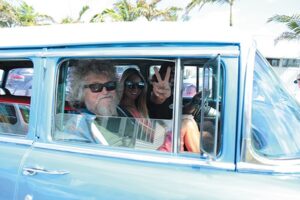
Ron Heavyside, an east coast surfing classic inside and out. Photo: Courtesy Nomad
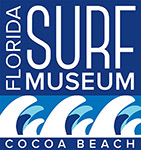

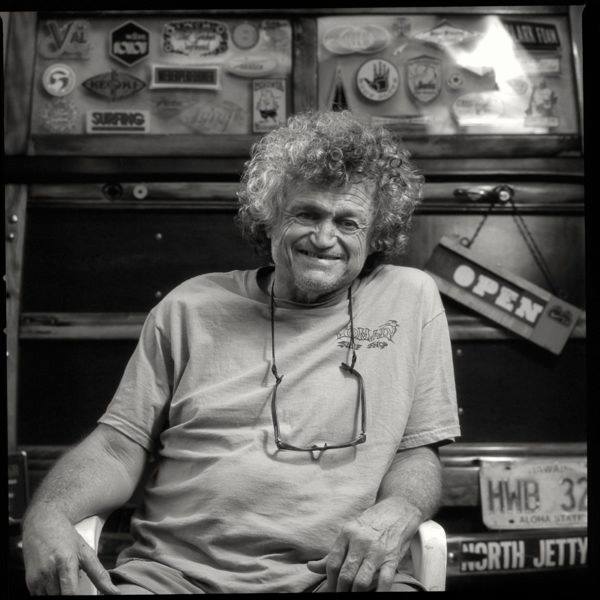

God Bless old buddy we had good times together over the years.
I worked for him when he hired me in tough times. I skateboarder for him as well. He helped a lot of kids with there SURFING and skating needs. As an inductee in the Florida Skateboard Hall of Fame now I have nominated him for an induction everyyear.Its very hard to get inducted but we will by him in hopefully soon. God bless you Ron and I hope to see you in VALHALLA brother. RIP
Chuck Lagana
R.i.p. Ron. You were a good friend. You will be missed. Had good times. Old days.
Truly sad to hear of Ron’s passing. He was a classic guy, great sense of humor, full of adventures good and bad and a friend you could trust and depend on. He and I were friends for 50 years
and we both surfed South Florida many times together. He had some artistic skills too and could freehand paint just about everything and he loved being in the shaping room carving foam.
We used to surf main beach in Delray at The Pole when Delray was a great South Florida surf break and a gathering spot for all of the Palm Beach and Broward County surf dogs. His
wife Beth who is also missed was larger than life, hibiscus tucked behind one ear and a smile that just made her glow. They were one hell of a couple and now their two sons Ryan and
Ronnie will carry on the name and traditions of Nomad.
You will be remembered forever and I personally will be missing my old friend. RIP Ron
Farewell Ron. He was always a good guy. I painted his nomad sign when he first opened way back when. I remember his mom and dad too. Briney wont be the same without him.
Ronald buddy old pal thanks for the job from 1975 to 1979 you were instrumental in making me who I am today. Nomad is a legendary brand dreamt up by a legendary man.
??♀️??♀️??♂️??♂️❤️❤️❤️❤️❤️??????
I was a classmate of his wife Beth. We are celebrating our 50th high school graduation this year, and miss her terribly. She was a wild , funny, vivacious woman until Ron got her into drugs and cocaine. The business grew because of her, and still thrives because of her vision. She was a special person, and I wish her sons had grown up knowing her.
Still have my Nomad 7’4″ Brewer design mini gun that you shaped for my 1974 can trip to Libertad, El Salvador. It worked especially well for me, thank you. Jay Evilscisor hooked me up with that hand shaped board and now both of of you are gone. Thanks for the stoke, and especially the sweet memories of classic surf, and boards!
Ron, thank you for helping me have an amazing life!
I remember Ron and surfed my old nomad after my hobie got trashed. Ron, Cole The agonda beast, Ratty, David The lounge was Dante’s Den and I played in a couple jams there in the 70’s. I lived in one of George Fosters little 200 sqft beach houses on the beach in Briney Breezes and I know Suzy Hess. but she won’t remember me.